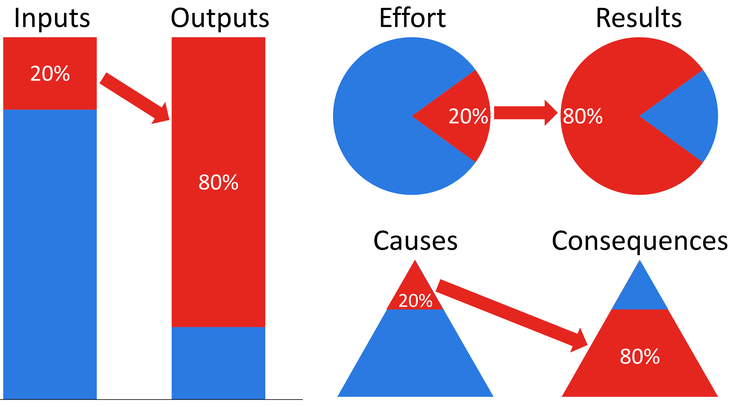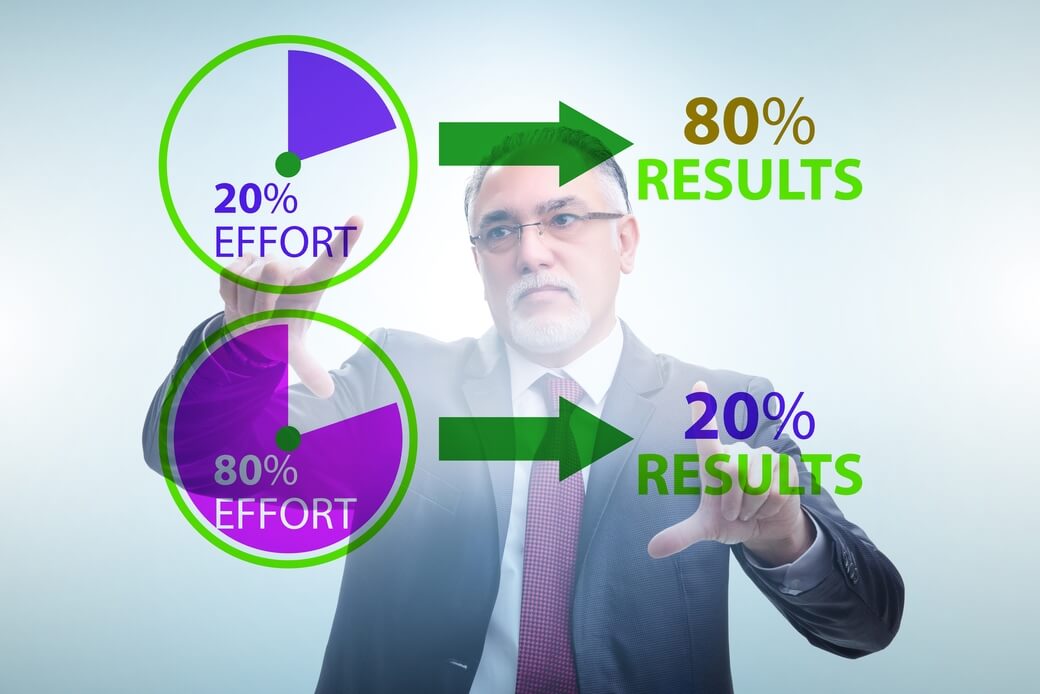Pareto Principle: Don’t Sweat the Small Stuff
The Pareto Principle (80-20 Rule; Law of the Vital Few) is a valuable quality management tool because its application encourages a focus on the most crucial issues.
For many events, roughly 80% of the effects come from 20% of the causes.
Vilfredo Pareto (1848–1923)
The Pareto Principle (also known as the 80/20 Rule or the Law of the Vital Few)

More than a century ago, an Italian economist by the name of Vilfredo Pareto observed that 80% of the land in Italy was owned by 20% of the population.
Subsequently, others observed a similar phenomenon in other situations, e.g. 80% of sales come from 20% of customers, 80% of the rise (or fall) in the value a stock portfolio comes from 20% of the stocks, 80% of complaints come from 20% of problems, 80% of results are contributed by 20% of the workers, etc. See the graphs below.

The Pareto Principle, or 80/20 Rule, is merely an approximation and applies to typical distributions. It could easily be 70/20 (e.g. 70% of complaints due to 20% of problems) or 90/10 (90% of work performed by 10% of staff). The numbers don’t necessarily need to add up to 100.
The principle is based on the fact that the distribution of most things is unequal. For instance, each worker in a company does not contribute exactly the same amount to the results, adverse events that occur in hospitals have different levels of impact on reputation, customer satisfaction, finance, etc.
Applying the Pareto Principle in Healthcare Quality Improvement
An interesting observation but how is it useful? A well-known business tool, the Pareto Principle can help you channel your resources to the most important items (the vital few) and give you the best bang for buck. For example, if long waits and billing issues in an Emergency Room (ER) are causing 70% of complaints by ER patients, then these two problems should be given priority (over a host of other issues) when selecting quality improvement initiatives.
Some hospitals make the mistake of trying to tackle every problem simultaneously because they all seem important. And they might be; in an ideal world you would address all the problems. However, realistically, you are more likely to have limited resources (staff, money, time), in which case paying attention to the items that matter the most would be a more effective management strategy.
Law of Diminishing Returns
Related to the 80/20 Rule, the “Law of Diminishing Returns” states that, in a production system, there will be a certain point at which additional units of input (workers, time, effort, materials) will yield increasingly negligible outputs (comparatively less improvement in the final result). This makes sense. For instance, if an ER is achieving, say, 95% reliability in providing all the recommended care components for community-acquired pneumonia, it would not be prudent to invest in more resources to improve the rate to, say, 97%.
A different situation might be another ER that is achieving only 50% reliability. The same amount of resources required to lift the performance of the first ER from 95% to 97% could easily improve the second ER’s from 50% to 85%.
We also suggested using the Pareto Principle and the Law of Diminishing Returns as a smart strategy to prepare for the CPHQ examination.
Subscribe to Our Newsletter
Subscribe to the CPHQ Tutor newsletter to receive ongoing information about CPHQ exam preparation, happenings in the CPHQ program, and our products and services.

Thank you for this interesting articles and i can appreciate the application in healthcare quality improvement. However my question is can we actually apply this principle in all walk of life? how about human resource management? if the organization is having an issue of 20% of workers produce 80% of the job, do you mean that the management should give special attention to the 20% high performers and continue to load them with work, at the same time paying less attention to the 80% low performers?
@Lim Zhi Ying – Thanks for your comment. The Pareto Principle can be applied to many walks of life. With respect to employee performance, all organizations grapple with the conundrum of rewarding/recognizing top achievers (the vital few) while getting more from the underperformers (trivial many). A tough but (I think) intriguing question. There will always be imbalance (the “unequal balance of things” mentioned in my article), i.e. 90/10, 80/20, 60/35, etc., and this imbalance is related to resources and results. If there was perfect balance, then we would have a perfect match of resources and results, e.g. 20% of resources (people, time, knowledge, physical assets, products, etc) contributing to 20% of the results – 20/20. A nice idea but this never happens in real life.
It is the constant imbalance that creates the opportunities to improve the organization’s productivity; more may potentially be squeezed out of the underperforming segment of the workforce. According to Drucker, one way of getting more output is by making people work smarter (not harder), e.g. reassigning non-clinical chores such as answering telephone calls from relatives and flower arrangement (that nurses used to do) to clerical staff (who are paid much less than nurses). By removing non-nursing tasks, nurses are freed to do their “real job” – caring for patients – hence becoming more productive; they would be contributing more to the desired results.
It’s the job of management to:
1. identify the imbalance between resources and results, and
2. improve the misallocation of resources, e.g. from 90/10 to 70/30, so that overall productivity is improved.
Closing the performance gap may require, say, removing the marginal performers and improving the below-average performers. Another effective strategy is to eliminate non-value adding activities – resources will be able to contribute more to the desired results, i.e. become more productive.
To answer your questions, I think management should allocate the “right” work, not more work, to top performers. The latter also deserve special recognition for their (disproportionately high) contribution to the organization’s success. At the same time, underperformers will need a great deal of attention in ways mentioned above.
I also believe that the application of Pareto to employee resources means identifying that 20% of top performers for higher rewards and better job functions/tasks and access to more resources for their performance improvement initiatives. Also, that 80% who aren NOT performing up to standard need to be evaluated and targeted for additional training or elimination. Why continue to pay someone who isn’t willing to improve and is not earning their keep. I don’t Pareto applies holistically to every situation but is a great tool for identifying disparities that need to be addressed or corrected. jtaylor